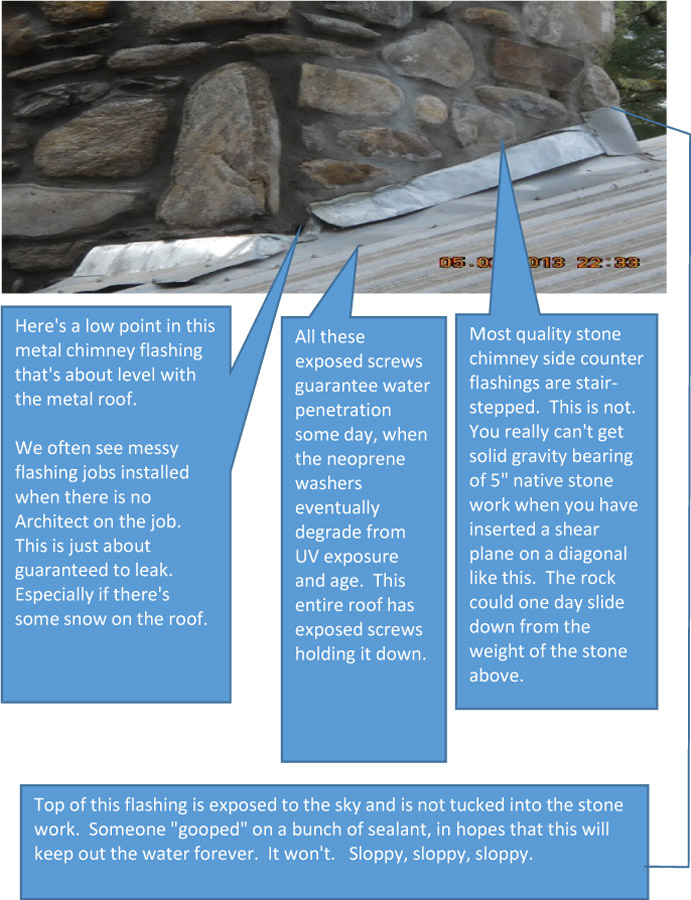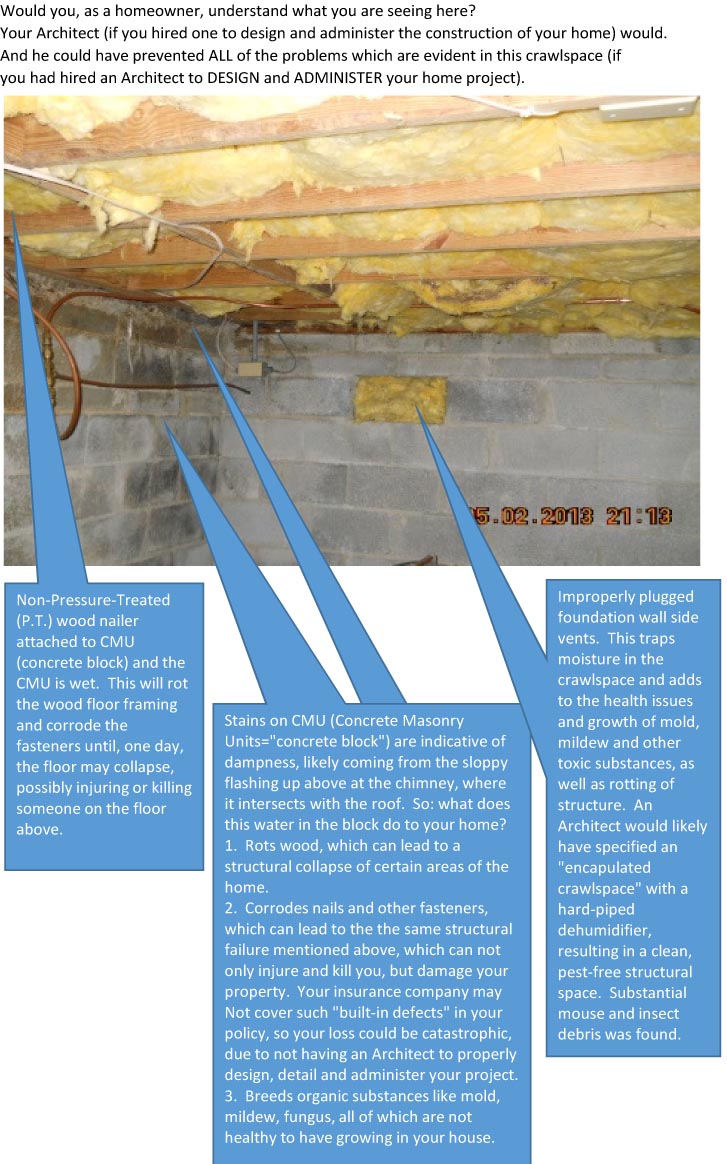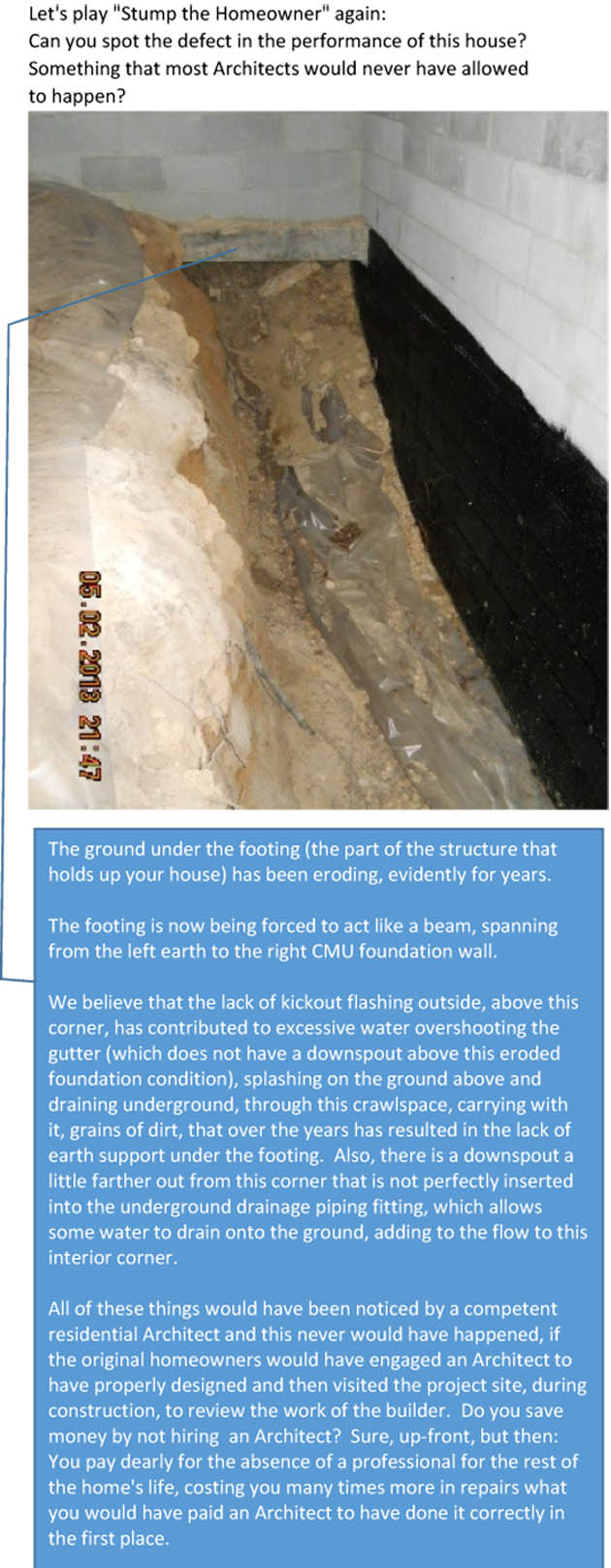You need an Architect to DESIGN and to ADMINISTER the Construction of your new house.
Why? Because the people who build your house, if left to themselves to design and build it on their own, may commit a multitude of sins (through lack of knowledge and lack of proper supervision) that can result in your residence leaking, rotting, collapsing, being structurally undermined through erosion, growing mold, and a host of other unpleasant and unhealthy results. Are the builders inherently bad, vindictive and evil people who want your house to rot, fall down and hurt you? Of course not. There are some excellent licensed General Contractors out there. But not all builders are licensed. And some know more than others. It is just that it is usually hard for one person or one company to be good at one thing, much less, trying to be all things to all people.
The idea presented here is that licensed General Contractors CAN do a very good job of building, when they just build and follow the detailed drawings and specifications of a licensed Architect. BUILDERS=BUILD. ARCHITECTS= DESIGN. The two working together on your behalf, gives you the best of both worlds: excellent design sensitivity and attention to technical details & specifications, along with professionally managed construction. A builder should no more attempt to design than an Architect should to build. Each has been educated and trained to do one or the other; not both. It is very difficult to master just one of these complex skills during a normal lifetime. We advocate for the enlightened participation of BOTH the Architect AND the Contractor in every project, including residential efforts. Especially in the design and construction of houses for people just like you.
We are going to share with you, in this article, just 3 of the possible conditions that you can have built into your house when you do Not have an Architect properly design it, detail it and administer its construction. Think that “minimum Code” and your Contractor can make sure everything will be okay? Well, take a look at some of the photos and discussions below and see if you really believe that, after seeing, with your own eyes, the evidence to the contrary. Rand Soellner, ArCH, NCARB, LHI, is the Senior Staff Architect with the HOME ARCHITECTS ®, one of the most experienced licensed residential Architects in the USA. He also happens to be a licensed Home Inspector. What he sees, in non-Architect designed houses during his inspections, built without the aide of an Architect’s oversight, will alarm and shock you. It may send you scrambling outside and into your crawlspaces to see if you have similar conditions there, waiting to cost you big bucks for some unexpected huge repair some day.
Let’s start at the top and work our way down: an examination of a chimney and its flashing. Flashing is the metal used to protect the joining of the chimney to the roof, so that hopefully, it does not leak. Flashing is supposed to be installed by professional builders that know what they are doing, because it is a critical component of the project: to leak or not. Take a look at how masterfully this builder handled this condition on this house. Obviously, there were no architectural details or an Architect around watching to make sure the job got done correctly:
Architects have to draw conditions like this and SOLVE them, not just let some guy on the job site (who must be looking forward to “Beer-Thirty”) to flail away at it like this.
We appreciate that construction is difficult, physically and mentally demanding work. We would never attempt it. That is why it is crucial to have conditions like these designed and resolved well before the people in the field attempt to build it. Then they can look at how it is supposed to be installed and do a much better job of dealing with the situations on the job site, resulting in a more functional and more attractive solution. And one that does a better job of keeping out the rain, snow and other moisture.
Okay, now for the 2nd item in our review of several conditions we often see during home inspections: leaking coming from above, coming down through walls and entering the crawlspace. Ready? Here we go:
Kind of frightening, isn’t it? EVERYTHING IS CONNECTED. Sort of like some Zen philosophy: how a butterfly’s wings can stir a little bit of air in the Himalayas and how that eventually ends up creating a hurricane on the New Jersey coastline. But in this case, the evidence is more direct: The bad chimney flashing work is obviously allowing water to come down that wall and to enter the crawlspace down below, where we are now. If an Architect had designed this project and also if the homeowner had paid him or her to be there once in a while during construction, this never would have happened. The Architect would have caught the bad flashing work and requested that it be done properly, and then this wall would not have water coming down through it; there would be no mold and the nailer board would have been pressure-treated (big deal: perhaps an extra $10 of investment in appropriate materials on your part) and the crawlspace would have been encapsulated and clean and dry.
Now then, how about a 3rd example of how things can go wrong without having an Architect designing and administering your project? Let’s take a look at another crawlspace and what is happening, right now, over there:
Okay? Are you a believer yet? There are thousands of things that can and do get built poorly every day; most of them without the design or input of an Architect. We will be adding more articles to this one, as we find more horrors.
Here’s a related recent article:
Why an Architect Should Design Your House.
And another article about the: Value of an Architect: Lighting.
And another about the: Value of an Architect: Roofing.
Thinking of having your house designed and built? Get it done right. Hire an Architect to design it and have him check things out during the build once in a while. You want your house to last a century or more, don’t you? You don’t like maintenance, do you? Do it right: Get an Architect.
Contact: Rand@HomeArchitects.com
Website: www.HomeArchitects.com



